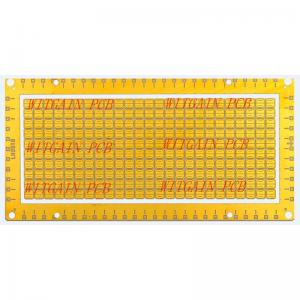0.4 MM AL2O3 Ceramic PCB Board 1 OZ Copper Thickness 2 Layer
Add to Cart
AL2O3 Ceramic PCB Board Thickness 0.4 MM 1 OZ Copper
Main Features:
1 Part NO: CeramicPCB0003
2 Layer Count: 2 Layer PCB
3 Material Kind: AL203 Ceramic
4 Finished Board Thickness: 0.4 MM
5 Copper Thickness: 1/1 um
6 PCB Size: 100mm*40mm
7 Application Area: RF Power Supply
Our Product Categories:
| Our Product Categories | ||
| Material Kinds | Layer Counts | Treatments |
| FR4 | Single Layer | HASL Lead Free |
| CEM-1 | 2 Layer/Double Layer | OSP |
| CEM-3 | 4 Layer | Immersion Gold/ENIG |
| Aluminum Substrate | 6 Layer | Hard Gold Plating |
| Iron Substrate | 8 Layer | Immersion Silver |
| PTFE | 10 Layer | Immersion Tin |
| PI Polymide | 12 Layer | Gold fingers |
| AL2O3 Ceramic Substrate | 14 Layer | Heavy copper up to 8OZ |
| Rogers, Isola high frequency materials | 16 Layer | Half plating holes |
| Halogen free | 18 Layer | HDI Laser drilling |
| Copper based | 20 Layer | Selective immersion gold |
| 22 Layer | immersion gold +OSP | |
| 24 Layer | Resin filled in vias | |
FAQ:
Q: What is Solder Flux? Why do we use it?
A: Solder Flux is a chemical cleaning agent used when soldering electronic components onto printed circuit boards. It is used in both manual hand-soldering as well as the different automated soldering processes used by PCB contract manufacturers.
Printed Circuit boards usually have copper traces which can oxidize when exposed to air or get contaminated while handling the board. This can prevent the formation of good solder joints. In order to remove this contamination and avoid oxidization, it is crucial that the board is cleaned with flux prior to soldering. Flux can be used to clean and remove these oxides and other impurities from the board.
Physically, Solder flux can be solid, semi-solid, or a liquid. It is usually available as a paste in jars/tin/cans. It is also available as a liquid in bottles. Flux-pens are generally used to apply flux when hand soldering.
Most often, a solder flux is available as an adhesive-like chemical compound nature and is responsible for holding the components in place until the reflow process. The flux also protects the metal surfaces from re-oxidation during soldering. The flux contains additives to improve the flow characteristics of the molten solder and thus helps in wetting of the board.
Categories of Flux
According to the electronics industry standards, J-STD-004, solder flux can be classified into 3 major categories based on its composition, activity (strength), the presence or lack of halide activators.
1. Rosin and Rosin Substitutes: Rosin flux is the oldest and still one of the most common fluxes used for electrical components. These fluxes are derived from a pine tree extract. Rosin flux is nearly inert at room temperature, gets active only when heated.
2. Water Soluble, or Organic acid flux: Organic acid flux is water soluble and can be cleaned with water, and hence the name. these fluxes are most commonly used for soldering electrical circuits. It cleans oxidation on electrical leads very quickly.
3. No-Clean: these fluxes are made with resins and various levels of solid residues. According to the name, these fluxes require little or no cleaning.
How is Flux Applied?
Solder flux can be applied on the board in a number of ways based on the soldering process being used.
Manual hand-soldering: Solder flux can be applied manually using a solder pen or in many cases flux is not mixed within the solder wire or solder bar. If the flux is mixed inside the solder, then simply heating the wire onto the surface with soldering iron is adequate. Alternatively, flux can be evenly spread on the surface of the board before applying the solder.
Wave Soldering: In this case, the flux is sprayed on the board prior to it going through the solder wave. Once in place, the flux cleans the components that are to be soldered. This removes any oxide layers that have formed. If the board is using a more corrosive type of flux, then the board will have to go through a pre-cleaning before the flux is applied.
Reflow Soldering: Solder flux used for the solder reflow process, is a paste composed of a sticky flux and small spheres of metal solder. Solder paste is a combination of a powder made up of metal solder particles and sticky flux that has the consistency of putty. They are generally mixed as a 50/50 ratio.
Here, the flux not only does its usual job of cleaning the soldering surfaces of impurities and oxidation, but it also provides a temporary adhesive that holds the surface mount components in place.
Selective Soldering: The flux is applied either by spraying it, or by using a more precise drop jet process. The precise drop-jet process is the application of flux to target locations without overspray.




